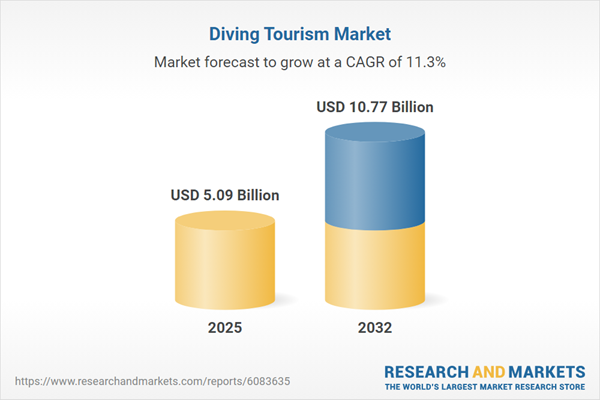Speak directly to the analyst to clarify any post sales queries you may have.
Diving tourism represents a dynamic, opportunity-rich sector shaped by technology, sustainability, and shifting traveler preferences. Senior decision-makers rely on actionable insights to better understand evolving market structures, capitalize on new growth avenues, and design resilient strategies within this global niche.
Market Snapshot: Diving Tourism Market Size and Growth Trajectory
The Diving Tourism Market grew from USD 4.56 billion in 2024 to USD 5.09 billion in 2025, with a projected CAGR of 11.34%, positioning the sector to reach USD 10.77 billion by 2032. This upward growth reflects steady demand for immersive underwater travel experiences and signals a competitive environment where adaptability and strategic differentiation drive success. Stakeholders equipped with market data and clear pathways for innovation will be best positioned to seize expanding opportunities and navigate emerging challenges in this specialized industry.
Scope & Segmentation: Diving Tourism Market
- Activity Types: Freediving, scuba diving (including advanced open water, deep dives, underwater photography, and wreck exploration), snorkeling, and technical diving diversify offerings and cater to all experience levels.
- Travel Arrangements: Cruise excursions, liveaboard experiences, resort-based programs, and shore excursions are tailored for various traveler interests and trip durations to increase engagement.
- Booking Channels: Direct booking, offline travel agents, and online travel agencies give travelers flexible and responsive paths to access the market.
- Price Tiers: Budget, mid-range, and luxury packages broaden appeal from entry-level participants to seasoned travelers seeking premium experiences.
- Experience Levels: Beginner, intermediate, and expert categories enable providers to customize products and deploy targeted marketing for greater customer satisfaction and retention.
- Geographic Regions: Americas (including North America and Latin America), Europe, Middle East, Africa, and Asia-Pacific feature distinct marine environments, each supporting specialized experiences and informed by local travel patterns.
- Key Companies Profiled: Liveaboards.com, Inc.; Scuba Travel Limited; Dive Worldwide Limited; Blue O Two International Limited; Master Liveaboards & Resorts Limited; Emperor Divers Limited; Caradonna Scuba Adventures, Inc.; Nautilus Liveaboards, Inc.; and Undersea Hunter Group, Inc. Reflecting leadership, these firms focus on innovation within packaged diving journeys and operational efficiency across markets.
Key Takeaways: Strategic Trends in Diving Tourism
- Companies are increasingly implementing advanced digital technologies, such as virtual previews and safety integrations, to improve access and enhance user confidence.
- Sustainability is now central, with sustainability priorities driving conservation programs and educational content embedded in many operators' core offerings to align with eco-aware traveler interests.
- Industry partnerships with local communities and research institutions yield unique diving experiences and support broader marine resource stewardship.
- Market access is expanding through diversified booking channels, with digital platforms boosting consumer trust and supporting real-time engagement for higher conversion rates.
- Hybrid business models that blend wellness, adventure, and conservation themes appeal to evolving client needs, supporting consistent performance and business resilience through changing market cycles.
- Providers are increasingly fine-tuning products to match local conditions and diver expectations, deepening customer loyalty and reinforcing regional market position.
Tariff Impact: Navigating Regulatory Headwinds
Recent tariffs imposed by the United States on specialized diving equipment have increased import costs for industry suppliers. To protect margins and quality, businesses are adjusting sourcing strategies and renegotiating supplier agreements. These changes impact pricing structures, travel destination choices, and intensify competitive pressures in cost-sensitive segments. However, segments prioritizing tailored or premium experiences continue to show resilience despite shifting cost dynamics.
Methodology & Data Sources
This report utilizes comprehensive desk research, in-depth industry interviews, direct field site evaluations, and consultative input from subject-matter experts. Data is validated from public statistics, operator disclosures, industry publications, and hands-on engagement to ensure actionable, accurate benchmarking and informed scenario planning.
Why This Report Matters
- Supports decision-makers in forecasting market developments and making strategic investments as regulatory, technology, and traveler trends evolve within diving tourism.
- Provides detailed segmentation and regional analysis to inform partnership strategies, innovation, expansion, and risk management initiatives across diverse market landscapes.
- Enables efficient market entry, operational optimization, and ongoing performance measurement with objective, thoroughly validated insights.
Conclusion
Diving tourism is transitioning through innovation, sustainability objectives, and evolving traveler motivations. This report delivers the strategic guidance needed to support effective action and reinforce competitive strength in this rapidly changing sector.
Table of Contents
3. Executive Summary
4. Market Overview
7. Cumulative Impact of Artificial Intelligence 2025
Companies Mentioned
The companies profiled in this Diving Tourism market report include:- Liveaboards.com, Inc.
- Scuba Travel Limited
- Dive Worldwide Limited
- Blue O Two International Limited
- Master Liveaboards & Resorts Limited
- Emperor Divers Limited
- Caradonna Scuba Adventures, Inc.
- Nautilus Liveaboards, Inc.
- Undersea Hunter Group, Inc.
Table Information
| Report Attribute | Details |
|---|---|
| No. of Pages | 195 |
| Published | October 2025 |
| Forecast Period | 2025 - 2032 |
| Estimated Market Value ( USD | $ 5.09 Billion |
| Forecasted Market Value ( USD | $ 10.77 Billion |
| Compound Annual Growth Rate | 11.3% |
| Regions Covered | Global |
| No. of Companies Mentioned | 10 |









